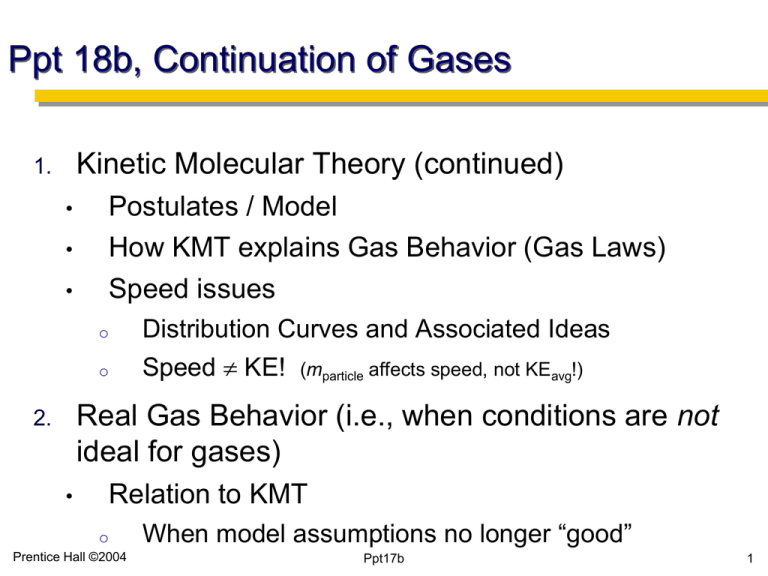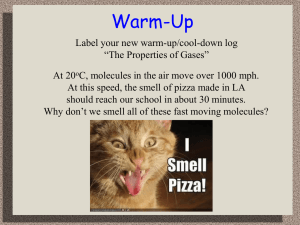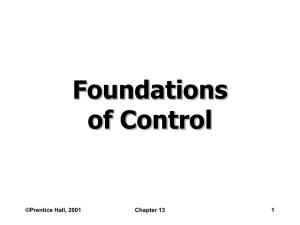
Ppt 18b, Continuation of Gases
Kinetic Molecular Theory (continued)
1.
•
•
•
Postulates / Model
How KMT explains Gas Behavior (Gas Laws)
Speed issues
o
Distribution Curves and Associated Ideas
o
Speed KE!
(mparticle affects speed, not KEavg!)
Real Gas Behavior (i.e., when conditions are not
ideal for gases)
2.
•
Relation to KMT
o
Prentice Hall ©2004
When model assumptions no longer “good”
Ppt17b
1
Kinetic Molecular Theory—formal postulates
(Recall the “superball” analogy!):
1)
Gas “particles” (atoms or molecules) move in straight lines
until they collide with something; Collisions with a
surface are the cause of the pressure exerted on it.
2)
Particle volume is negligible (technically, zero)
compared to gas volume (vessel volume)
3)
4)
Distance between particles is HUGE compared to
particle diameter; Most volume is “empty space”
Gas collisions are perfectly elastic & particles do not
exert any forces on one another between collisions
Average Kinetic Energyparticle Kelvin Temperature
Prentice Hall ©2004
Slide 2
Kinetic Energy is Energy of Motion
KEparticle
1
2
mv
2
m = mass of (a single) particle
v = speed of (a single) particle
•
(strictly speaking, velocity)
At any temperature, particles are always moving
and colliding with “walls” (surfaces)
Average KEparticle TKelvin
If T increases, particles mover faster and collide
“harder” [NOTE: If you double T, speed does
Prentice Hall ©2004
not double! It increases by 2 times (~1.4 x)
•
Reminder: Gas Law Behavior
(But let’s “rewrite” Ideal Gas Law in terms of pressure)
Ideal Gas LAW: PV = nRT
nRT
n
P
P xRT
V
V
n
P
V
(if T constant)
concentration
P T
n
(if
constant)
V
**These descriptions of “what happens” are not
explanations!!! How KMT explains these laws is on
the next slides.**
Prentice Hall ©2004
Derivation of Ideal Gas Eqn. from KMT—
Pressure is a result of collisions
•
•
The pressure exerted by a gas comes from the
sum of huge numbers of collisions against a
surface in a given period of time (say a second)
The pressure equals the product of the average
“force per collision” and the # of collisions per sec
(per unit of area):
"force"
# of collisions
P
x
collision
sec (per unit area)
Prentice Hall ©2004
Frequency of
collisions
Assertions (used to derive Ideal Gas Eq. from KMT)
•
“Force per collision” depends on momentum (mv)
of particle
1)
2)
•
If more massive, more “oomph” (at given speed)
If moving faster, bigger impact (for a given m)
Collisional frequency depends on
1)
2)
Concentration of particles (more particles, more
collisions each sec (n/V)
Speed of particles (if they move faster, more can
“reach” the wall in a given sec) (v)
*Tro gives a more detailed description and derivation
Prentice Hall ©2004
Slide 6
Substitute in!
"force"
# of collisions
P
x
collision
sec (per unit area)
P
mv
P
mv
P
Prentice Hall ©2004
2
T
n
x xv
V
n
x
V
n
x
V
Ideal Gas
Law!!
Slide 7
KMT—Pressure is a result of collisions
(Explains gas laws via P and “mechanical equilibrium” idea)
•
At a given T (and for a given gas), the frequency of
collisions depends on the concentration of gas
particles:
→ More particles in a given volume more collisions
per second with each m2 of “wall” increased P
•
At a given concentration, higher T higher
average KE, which results in:
1) More collisions per second (at a given [gas])
→ because speed increases [but not proportionately!]
2) “Harder” (more forceful) collisions
→ because speed increases (greater “momentum”)
Prentice Hall ©2004
Increased
P
Example: Syringe and Balloon in Syringe
(How does KMT explain what you see?)
•
Watch the demo (what do you predict?)
•
Can you explain why using KMT?
•
NOTE: These are “constant temperature”
situations.
P collisional frequency concentration (T const)
Prentice Hall ©2004
Chapter 09
Slide 9
Simulations of KMT
•
http://intro.chem.okstate.edu/1314F00/Laboratory/
GLP.htm
•
http://celiah.usc.edu/collide/1/
--allows changes in mass / particle and gas mixtures
•
http://www.falstad.com/gas/
•
http://mc2.cchem.berkeley.edu/Java/molecules/ind
ex.html
Prentice Hall ©2004
Any given gas law between two variables can
be “explained” using KMT
•
I’ll show figures from a prior textbook on the next
three slides
1
o P
(T , n constant)
V
o P T (V , n constant)
o
•
V T
(P, n constant)
Tro gives verbal explanations of laws on p. 207
Prentice Hall ©2004
Chapter 09
Slide 11
A Decrease in Volume increases Pressure by
increasing the # collisions per sec
Is the average speed of the particles different in the second
NO!
box? (Hint: is T different?) ____
Greater concentration
(n/V) at same T leads
to greater collision
frequency without a
speed increase!
Prentice Hall ©2004
Copyright © Houghton Mifflin Company. All rights reserved.
5–12
An increase in T increases P by increasing both the
# collisions per sec AND the “force” per collision
This assumes that the V is kept constant (could be a rigid container, although
here a flexible container is shown with extra masses on the piston).
Average KE increases…so
Hitting walls
more often
Hitting walls
“harder”
Prentice Hall ©2004
5–13
An increase in T at constant P leads to an increase in V so
that collisional frequency can decrease to offset increased
force per collision
Why? After T , Pgas > Pext not in mech equilib piston moves out!
and concentration ends
up decreasing to
compensate (P “held
constant” here)
Prentice Hall ©2004
Copyright © Houghton Mifflin Company. All rights reserved.
5–14
Kinetic Molecular Theory—Distribution Curves
What does it mean if the bar is “taller” on this plot?
Which bar represents the highest temperature?
How would the plot for Los Angeles be expected to differ from the plot below
during this same time period?
Prentice Hall ©2004
Chapter 09
Slide 15
Kinetic Molecular Theory—Distribution Curves
Prentice Hall ©2004
Chapter 09
Slide 16
Kinetic Molecular Theory—Distribution Curves
Prentice Hall ©2004
Chapter 09
Slide 17
Distribution Curve Comments (see simulation applet!)
1) When T is raised, average KE goes up, so a given
sample’s average speed will go up, shifting the
distribution curve to the right (max is further right).
2) Total area under the curve represents the total number of
particles of a certain gas in the sample.
3) If TWO gases are present in the same container, each
one’s distribution curve will have a different height,
proportional to how much of that gas is present (and thus
partial pressure [this topic will be covered later]).
4) Also, if T is the same, the average speed of MORE
MASSIVE particles will be LOWER than less massive
ones (maximum further to the LEFT). [See next slide]
Prentice Hall ©2004
Chapter 09
Slide 18
Kinetic Molecular Theory—Speed ≠ KE!!
“Big guys move more slowly at the same T”
Same T Same avg KE if m bigger, v smaller
1
KE mv 2
2
Prentice Hall ©2004
Chapter 09
Slide 19
Figure 5.23 “Big guys” move more slowly at same T”
Which gas has the
greater average
kinetic energy?
Ans: Neither!
Same T Same
KEavg!
REMEMBER:
KE ≠ speed!
Prentice Hall ©2004
Copyright © Houghton Mifflin Company. All rights reserved.
5–20
Real Gases Deviate from Ideal Behavior at low
T and high P
Prentice Hall ©2004
Chapter 09
Slide 21
At STP, some gases act fairly ideally:
Prentice Hall ©2004
Prentice Hall ©2004
Prentice Hall ©2004
KMT explains why the deviations occur at low
T and high P!
•
Deviations from ideal behavior occur under conditions
where the assumptions of the model (of an ideal gas) are no
longer “good” assumptions for real gases!
1.
Molecules in gaseous state do not exert any force on
one another between collisions.
•
NOT ACTUALLY TRUE! [intermolecular forces exist between “real”
molecules]
•
but good approximation if T is large! (High KE “overcomes” weak forces)
ASSUMPTION “BREAKS DOWN” at low T
2.
Volume of the molecules is negligibly small compared
with that of the container.
•
Prentice Hall ©2004
NOT TRUE if really compressed!! BAD ASSUMPTION at high P (high n/V)
Slide 25
At high P, n/V increases and Vparticle not negligible
Prentice Hall ©2004






